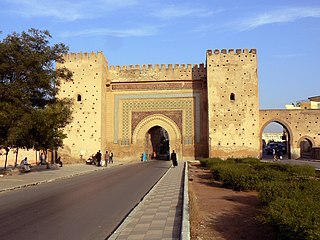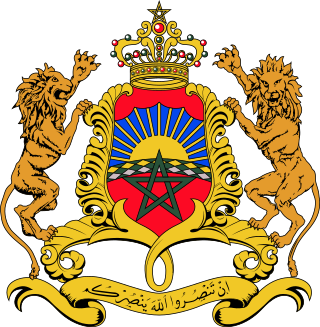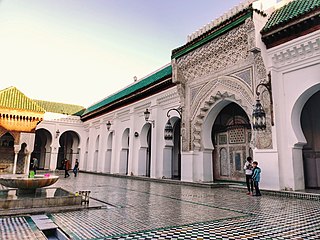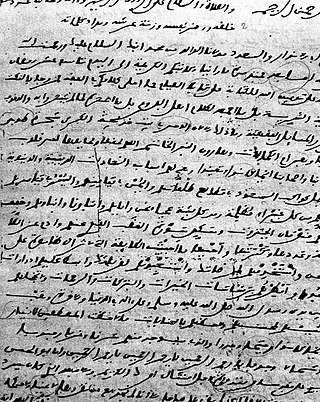
Sufism is a mystic body of religious practice found within Islam which is characterized by a focus on Islamic purification, spirituality, ritualism, and asceticism.

Moulay Ismail Ibn Sharif was a Sultan of Morocco from 1672 to 1727, as the second ruler of the 'Alawi dynasty. He was the seventh son of Moulay Sharif and was governor of the province of Fez and the north of Morocco from 1667 until the death of his half-brother, Sultan Moulay Rashid in 1672. He was proclaimed sultan at Fez, but spent several years in conflict with his nephew Moulay Ahmed ben Mehrez, who also claimed the throne, until the latter's death in 1687. Moulay Ismail's 55-year reign is the longest of any sultan of Morocco. During his lifetime, Isma’il amassed a harem of over 500 women with more than 800 confirmed biological children, making him one of the most prodigious fathers in recorded history.

Meknes is one of the four Imperial cities of Morocco, located in northern central Morocco and the sixth largest city by population in the kingdom. Founded in the 11th century by the Almoravids as a military settlement, Meknes became the capital of Morocco during the reign of Sultan Ismail Ibn Sharif (1672–1727), son of the founder of the Alaouite dynasty. Sultan Ismail created a massive imperial palace complex and endowed the city with extensive fortifications and monumental gates. The city recorded a population of 632,079 in the 2014 Moroccan census. It is the seat of Meknès Prefecture and an important economic hub in the region of Fès-Meknès.

The 'Alawi dynasty – also rendered in English as Alaouite, 'Alawid, or Alawite – is the current Moroccan royal family and reigning dynasty. They are an Arab Sharifian dynasty and claim descent from the Islamic prophet Muhammad through his grandson, Hasan ibn Ali. Their ancestors originally migrated to the Tafilalt region, in present-day Morocco, from Yanbu on the coast of the Hejaz in the 12th or 13th century.

A dargah is a shrine or tomb built over the grave of a revered religious figure, often a Sufi saint or dervish. Sufis often visit the shrine for ziyarat, a term associated with religious visitation and pilgrimages. Dargahs are often associated with Sufi eating and meeting rooms and hostels, called khanqah or hospices. They usually include a mosque, meeting rooms, Islamic religious schools (madrassas), residences for a teacher or caretaker, hospitals, and other buildings for community purposes.

MawlaySulayman bin Mohammed, born on 28 June 1766 in Tafilalt and died on 28 November 1822 in Marrakesh, was a Sultan of Morocco from 1792 to 1822, as a ruler of the 'Alawi dynasty. He was proclaimed sultan after the death of his half-brother al-Yazid. Sulayman continued his father's centralization and expansion of the kingdom, and most notably ended the piracy that had long operated from Morocco's coast. As part of Morocco's long running conflict with Spain and Portugal, Sulayman halted all trade with Europe. However, he continued his father's policies of close relations with the United States. He was also a follower of Wahhabism.
Sidi Mohammed ben Abdallahal-Khatib, known as Mohammed III, born in 1710 in Fes and died on 9 April 1790 in Meknes, was the Sultan of Morocco from 1757 to 1790 as a member of the 'Alawi dynasty. He was the governor of Marrakesh around 1750. He was also briefly sultan in 1748. He rebuilt many cities after the earthquake of 1755, including Mogador, Casablanca, and Rabat, and Abdallah Laroui described him as "the architect of modern Morocco." He also defeated the French in the Larache expedition in 1765 and expelled the Portuguese from Mazagan (al-Jadīda) in 1769. He is notable for having been the first leader to recognize American independence in his alliance with Luis de Unzaga 'le Conciliateur' through correspondence and Unzaga's secret intelligence service and led by his brothers-in-law Antonio and Matías de Gálvez from the Canary Islands. He was the son of Mawlay Abdallah bin Ismail and his wife a lady of the Chéraga guich tribe.

Abū 'Abdullah Muḥammad ibn Sulaymān ibn Abū Bakr al-Jazūli al-Simlālī, often known as Imam al-Jazuli or Sheikh Jazuli, was a Moroccan Sufi Saint. He is best known for compiling the Dala'il al-Khayrat, an extremely popular Muslim prayer book. This book is usually divided into 7 sections for each day of the week. Al-Jazuli is one of the seven saints of Marrakesh and is buried in his mausoleum inside the city.

The Isawiyya is a religious Islamic mystical brotherhood founded in Meknes, Morocco, by Sheikh al-Kamil Mohamed al-Hadi ben Issa (1465–1526), best known as the Shaykh Al-Kamil, or "Perfect Sufi Master". The terms Aissawiyya (`Isawiyya) and Aissawa (`Isawa), derive from the name of the founder, and respectively designate the brotherhood and its disciples.
Ahmad Zarruq also known as Imam az-Zarrūq ash Shadhili was a 15th-century Moroccan Shadhili Sufi, jurist and saint from Fes. He is considered one of the most prominent and accomplished legal, theoretical, and spiritual scholars in Islamic history, and is thought by some to have been the renewer of his time (mujaddid). He was also the first to be given the honorific title "Regulator of the Scholars and Saints". His shrine is located in Misrata, Libya, however unknown militants exhumed the grave and burnt half the mosque.
Sidi Abderrahman el Majdoub, also transcribed as Mejdub, full name al-Shaykh Abu Zayd Abderrahman al-Majdoub ibn Ayyad ibn Yaacub ibn Salama ibn Khashan al-Sanhaji al-Dukkali, was a Moroccan poet, Sufi and mystic. Many lines of his poems are known throughout the Maghreb, and his work is the source of many proverbs.

The history of Marrakesh, a city in southern Morocco, stretches back nearly a thousand years. The country of Morocco itself is named after it.

Fez or Fes is a city in northern inland Morocco and the capital of the Fez-Meknes administrative region. It is one of the largest cities in Morocco, with a population of 1.256 million, according to the 2024 census. Located to the northwest of the Atlas Mountains, it is surrounded by hills and the old city is centered around the Fez River flowing from west to east. Fez has been called the "Mecca of the West" and the "Athens of Africa". It is also considered the spiritual and cultural capital of Morocco.
The following is a timeline of the history of the city of Meknes, Morocco.

The Zawiyaof Sidi Abdelkader al-Fassi, also known as the Zawiya al-Fassiya, is one of the most important historical zawiyas in Fes, Morocco. It is named after Sidi Abdelkader al-Fassi, a highly important 17th-century Muslim scholar, mufti, and Sufi saint of the city who is buried in the zawiya. The building is located in the Qalqliyin neighbourhood in the south of Fes el-Bali, the old medina of Fes. It was one of several zawiya sites in the city and across the country which were associated with the al-Fassiya tradition of Sufism.

Muhammad Bin Abdul-Kabir Al-Kattani, also known by his kunyaAbu l-Fayḍ or simply as Muhammad Al-Kattani, was a Moroccan Sufi faqih, reformer, and poet from Fes. He is recognized as the father of the Moroccan constitution movement and the leader of the Conditioned Bay'ah of 1908. He was also vocally opposed to the metastasizing French colonial presence in Morocco, and launched at-Tā'ūn, the first national newspaper in Morocco. He was a member of the al-Kattani family and the Tariqa Kattania, a Sufi order. He composed over 300 works, printed 27 of them, and wrote Sufi philosophical love poetry. He was accused of treason and flogged to death under Sultan Abdelhafid.

The Shaykh al-Kamil Mausoleum, romanized as Cheikh Al Kamel Mausoleum also known as the Mausoleum of al-Hadi ben Issa is a historic religious complex located in Meknes, Morocco.
Mohamed ben Issa may refer to:












